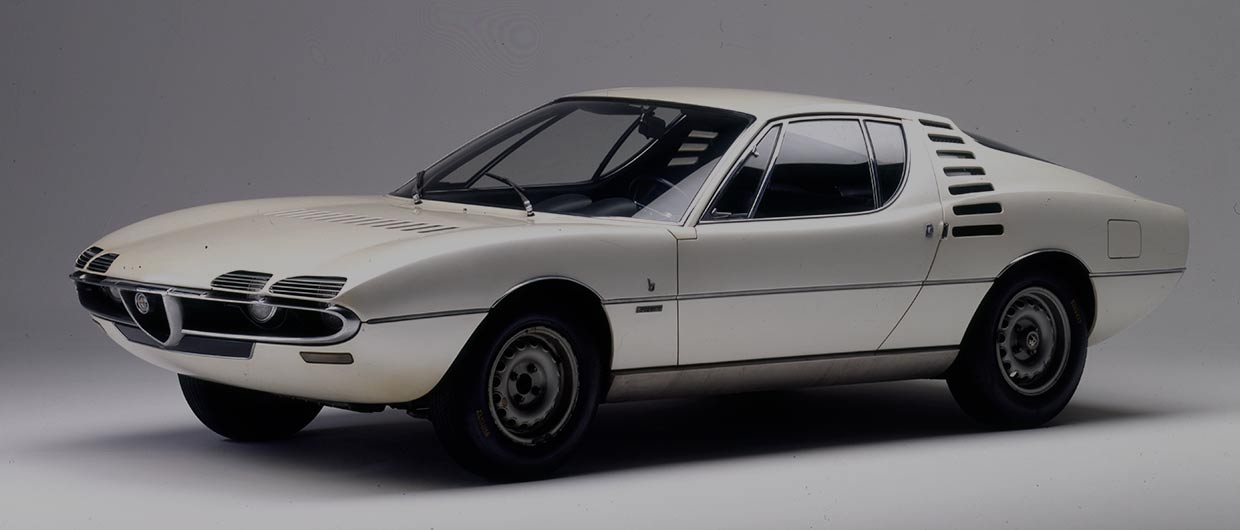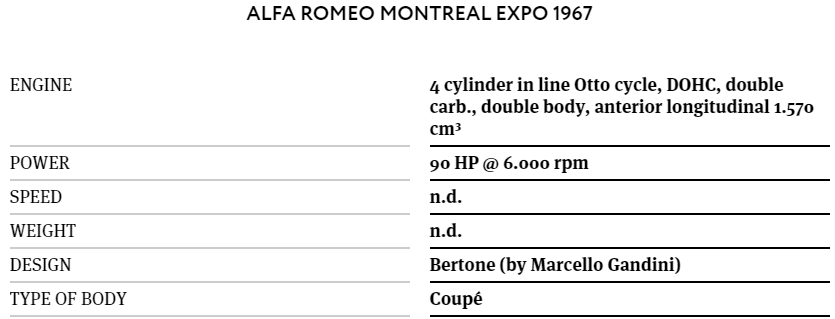
The Alfa Romeo Montreal is a distinctive and celebrated model from the storied Italian automaker, Alfa Romeo. Here’s an in-depth look at this unique vehicle:
Overview
- Model Year: 1970-1977
- Manufacturer: Alfa Romeo
- Designer: Marcello Gandini for Bertone
- Production Years: 1970-1977
- Total Units Produced: Approximately 3,900
Design and Styling
- Body Style: 2-door coupé
- Design: The Montreal was designed by Marcello Gandini of Bertone, who is also known for designing the Lamborghini Miura. The car features distinctive styling elements, including the slatted headlight covers that retract when the lights are turned on, the NACA duct on the hood, and the muscular rear fenders. Its aggressive and futuristic look made it stand out during its era.
Engine and Performance
- Engine: 2.6-liter V8 engine derived from Alfa Romeo’s racing program
- Power Output: Approximately 200 horsepower
- Transmission: 5-speed manual gearbox
- Top Speed: Around 137 mph (220 km/h)
- Acceleration: 0-60 mph in approximately 7.1 seconds
- Performance: The Montreal’s V8 engine, equipped with SPICA mechanical fuel injection, provides robust performance and a thrilling driving experience. It was known for its smooth and responsive power delivery.
Chassis and Suspension
- Chassis: Steel monocoque
- Suspension:
- Front: Independent with coil springs, telescopic shock absorbers, and an anti-roll bar
- Rear: Live axle with coil springs, telescopic shock absorbers, and an anti-roll bar
- Brakes: Disc brakes on all four wheels
Interior
- Seating: 2+2 seating configuration
- Dashboard: Features a driver-oriented design with comprehensive instrumentation and a mix of analog gauges. The interior is well-appointed with high-quality materials and a sporty, yet comfortable, layout.
Features
- Unique Styling: The retractable slatted headlight covers and hood-mounted NACA duct are signature elements.
- Luxurious Interior: The car includes leather seats, wood trim, and advanced (for the time) features such as air conditioning and power windows.
Legacy and Impact
- Introduction: The Montreal was first introduced as a concept car at the 1967 Montreal Expo (hence the name) and received significant acclaim, leading to its production version debut in 1970.
- Rarity: With only about 3,900 units produced, the Montreal is a rare and desirable collector’s item.
- Collector Status: The Montreal is highly prized among classic car enthusiasts for its unique design, performance, and status as a symbol of 1970s automotive innovation.
Significance
- Technological Innovation: The use of a detuned version of Alfa Romeo’s racing V8 engine was a significant move, providing the car with an advanced and powerful engine for its time.
- Market Position: The Montreal was positioned as a high-end sports car, competing with other premium European sports cars of the era.
The Alfa Romeo Montreal is remembered for its striking design, advanced engineering, and spirited performance. It remains a symbol of Alfa Romeo’s commitment to innovation and style, encapsulating the essence of Italian automotive excellence from the 1970s.
Production was split between the Alfa Romeo plant in Arese and Carrozzeria Bertone’s plants in Caselle and Grugliasco outside Turin. Alfa Romeo produced the chassis and engine and mechanicals and sent the chassis to Caselle where Bertone fitted the body. After body fitment, the car was sent to Grugliasco to be degreased, partly zinc coated, manually spray painted and have the interior fitted. Finally, the car was returned to Arese to have the engine and mechanicals installed. It is worth noting that because of this production method, there is not necessarily any correspondence between chassis number, engine number and production date.
The Montreal remained generally unchanged until it was finally removed from pricelists in 1977. By then, production had long ceased as Alfa struggled to sell its remaining stock. Total production was around 3,900.
None of them were sold in Montreal since Alfa did not develop a North American version to meet the emission control requirements applied in the United States and Canada


For the 1967 Universal Exposition in Montreal, Alfa Romeo was selected from among all international manufacturers to present a car that represented the “highest aspiration of modern man in terms of cars”.
Mike Nichols’ film “The Graduate”, which was released in 1967, celebrated the Spider Duetto as one of the most desirable cars in the United States and worldwide, because it encapsulated the spirit of freedom that pervaded those years. It was a golden age for Alfa Romeo, which became a global icon of cool. The Milanese automaker’s popularity did not escape the organisers of EXPO 1967, the theme of which was “Man and His World”. Alfa was asked to build a car that represented the ultimate incarnation of motoring at the time.
However, the Universal Exposition was only nine months away and the company’s elation at being selected for this honour was tempered by the pressure of having to create an exceptional car in record time. Producing a car completely from scratch was out of the question, so the Giulia Sprint GT was chosen as a base and Carrozzeria Bertone was commissioned to style the bodywork.
In Bertone’s workshop, 29-year-old Marcello Gandini designed an elegant, low and streamlined coupé. The originality of the design owed much to the low radiator grille and plunging bonnet that half-concealed the headlights behind distinctive louvred eyelids, a novel and innovative solution that improved the car’s aerodynamic profile. The car’s sloping windscreen, two long L-shaped doors and six air vents on each C-pillar were also among the many stylistic features that would become iconic of this model. Other distinguishing touches included the almost horizontal glass tailgate, the Kamm tail-cum-spoiler and the double twin tailpipe in the centre. Two identical specimens were made, both painted in pearl white.
The two concept cars – which are now called the Alfa Romeo Montreal Expo – were exhibited at the entrance to the Universal Exposition, in the pavilion entitled “Man the Producer”. By means of a peculiar effect using mirrors, the image of the two prototypes was infinitely repeated throughout the exhibition space. Both cars are now part of the FCA Heritage collection and are kept in the Alfa Romeo History Museum.
The extraordinary success of the two concept cars at the 1967 Expo convinced the Alfa Romeo management to create a coupé very similar to the Bertone prototype, but with upgraded mechanicals including a powerful V8 engine from the 33 Stradale.
Marcello Gandini further flexed his design talent by converting the EXPO ’67 prototype into a mass-produced touring berlinetta. The bonnet was raised to accommodate the V8 engine from the 33 Stradale, the displacement was increased to 2.6 litres and power output was decreased from 130 HP to around 77 HP/litre to make the car more docile and suitable for road use. The exterior styling was also tweaked and the mass-produced Montreal rode slightly higher than the two prototypes displayed in Canada, although the headlight blinds were retained. The varied range of available colours accentuated the vehicle’s personality and catered to contemporary tastes, almost in contrast with the “lunar” pearl white finish chosen for the two concept cars. The most eye-catching colours were metallic gold, Verde Termico green, Marrone Luci Di Bosco brown beige and iconic lobster orange, as seen on the specimen exhibited at the Alfa Romeo Museum in Arese.
The Montreal was presented at the Geneva International Motor Show in March 1970, but only became available to order two years later. The price was set at 5,700,000 lira.
Between 1970 and 1977 a total of 3925 cars were produced. This limited number was due to the decline in popularity of sports cars caused by the oil crisis of the 1970s. Even today it remains a crowd-pleaser due to its shapely figure and elegance, traits it shared with Hollywood divas during its heyday. And Hollywood doesn’t seem to have forgotten the Montreal: in 2017 a magnificent rare specimen in black made a standout cameo appearance alongside Charlize Theron in the movie Atomic Blonde.



You must be logged in to post a comment.